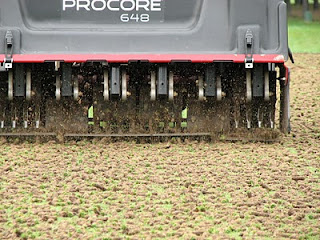I wanted to give an update on projects scheduled for this year. The fairway bunkers on #7 have been invaded by tree roots and are lacking sand. These bunkers have moved up the priority list and will be renovated in the next month.
The addition of fairway bunkers on #12 will not happen this year. These bunkers will frame the hole on the left side and give much needed separation between holes #12 & 13. The main reason these bunkers won't be installed is the lack of resources & time.
Notice the large "silt cloud" after Zebra Mussells have been evacuated using a high pressure jet (cost $1200 annually to flush line will now be eliminated).The pond in front of #13 will be renovated and completed in the next few weeks. This pond will meet many needs, but most importantly reduce the impact of zebra mussells and help filter elevated levels of sediments found in canal water used to irrigate the golf course.
Most tree stumps have been ground and stumps holes filled and seeded. The remaining tree stumps could not be completed due to time constraints and location. A stump grinder is a very destructive machine that is difficult to control if it's not on level surfaces. We had safety concern issues on hill sides and with some time and weather the stumps soften and are possible to grind.


















